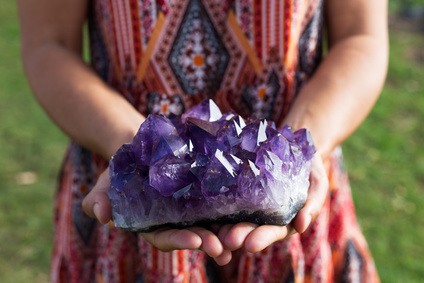This is the month of the divinely beautiful Amethyst. A gemstone often identified with royalty. Some call it the “jewel of the gods”, though where that saying originated from, I can not tell. However, it seems fitting as the color purple has been associated with royalty from the beginning of time. The most popular type of quartz, Amethyst gets its lovely purple hue from iron deposits. The value of this stone comes not from its size, but from its color. The most desirable color is a deep medium purple with red overtones and is referred to as “Deep Siberian” or “Deep Russia”.
[Article to read: Royal Amethysts]
GIFT GIVING
Amethyst is most widely known as the birthstone for February. In addition, you may find it recommended as a gift for the 4th, 6th, and 17th anniversary. It is beautifully set as a large stone in earrings or a necklace. The Amethyst can also be found as a druzy which makes a stunning statement piece. It is perfectly suited for a custom fine jewelry piece.
HISTORY
The Amethyst has a long history. Formerly known as one of the cardinal gems, it was one of the most prized and rare stones in ancient times. However, in the 18th century, many vast deposits were discovered around the world, making this purple gem more accessible and subsequently lowering its value. Yet, it has retained its popularity.
It was used by Ancient Greeks to prevent drunkenness (the name means “sober”) and Medieval soldiers believed it could heal and keep them cool-headed. The Tibetans consider the Amethyst to be sacred and are used in prayer beads by the Buddhists. In the Bible, the Amethyst was one of the 12 stones used in the breastplate of Aaron and identified as the 12th foundation stone of the New Jerusalem. Later centuries continued to see the use in sacred positions as Bishops would wear the amethyst in rings and even St. Valentine wore it to symbolize purity. Some legends say he had in his possession an amethyst carved with cupid.
SYMBOLISM
There are many meanings of the Amethyst all associated with ancient traditions and folklore. As mentioned before, it primarily was believed to prevent drunkenness. As a result, royal goblets would be made of pure Amethyst as a way to ward of imbibing too much wine.
In addition, it is best known throughout the ages to make the wearer a more gentile folk. Encouraging one to be calm and contemplative. Along the same lines, it is associated with memory and mental health issues. During the Renaissance period, it symbolized humility and modesty. Among Catholic priests, it was a symbol of piety and often worn as jewels set in their crosses.
For the Hebrews, the word Amethyst in Hebrew means “dream”, resulting in some using this popular stone near the bed for a good night’s sleep.
CLEANING
Sunlight and exposure to heat cause the color of amethysts to deteriorate, unless it has been heat-treated. Avoid any contact with chemicals such as household cleaners or hairspray. To clean, use a soft toothbrush or cloth and a solution of mild dish soap and warm water to gently scrub the stone.
Whatever it is about the Amethyst that you love – the purple color or the symbolism it offers – we’d love to help you find that perfect piece of jewelry or to set a stone that you may have laying in the back of a drawer somewhere. We can even reset a family heirloom.
Call us at 719-232-8122 or stop by our store at 111 N. Tejon St., Colorado Springs, CO 80903. We’re your Colorado Springs jeweler!


